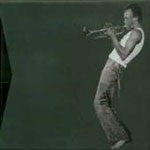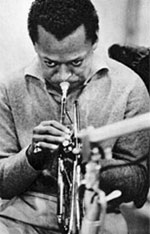the Miles Davis/Jack Johnson archives

“That’s some raunchy shit, John” (Thus spake Miles to John McLaughlin, end of ‘Duran’ Take 4)
While the number of Miles Davis reissues gathers at a frightening pace, it repays the effort to focus on the specifics for a while. Take one record and live with it, let it follow you into your dreams, accompany you on daily walks, be the guiding principle behind digging for gold and reaching for obscure gems. Miles occasionally Smiled, but he was better known for his hoarse whisper and predilection for streetwise hustle and trend-setting quantum leaps beyond the current norm.
Miles ought to be renamed Whispering Death, a tantalising vision of severed vocal cords and whiplash obscenities. A Whispering Death to rival the great West Indies fast bowler Michael Holding, who was originally given the moniker. Holding, launching his run-up at speed but with effortless ease, would be the scourge of opener and tail-ender alike, the feet barely registering a sound on his way to the crease, but the release of the ball would too often be followed by the sharp death-knell crackle of tumbling stumps. Whispering Death.
And so it is that the same dichotomies and symmetries inform the mighty reissue of the Jack Johnson sessions on a further box set in Columbia’s odyssey into the Miles archives. Featuring the electric-era sound at its prime, the line-up includes Sonny Sharrock and John McLaughlin injecting the guitar-styled meat behind Miles’s sputterings and angular interjections. The box is a monument both to the men behind the sport of boxing, and to the team spirit informing those dark journeys into electronic badass rhythms Miles conjured with in the early 1970’s.
Take one or take five, the project reveals the same gleeful combination of menace and quick-fire volatility behind the musical invention. On records like these, and supported by slashing guitar-fuelled upper-cuts, Miles reveals himself as bad like Zorro, the amoral Zorro of the silent-film era, where all the mystery is preserved in Douglas Fairbanks’ glower and erotic allure. Fairbanks the canvas-slashing scene-stealer, with the pearly white Mack the Knife teeth.
The impertinence of the Jack Johnson record(s) is one which fully accords with its subject. Boxing is a language of upper cuts and distorted limbs, but also erotic clinches, (south-)pawing, struggling with nether regions and puff-ball gloves. For every clean punch there are a dozen swipes and miscues, the thought of the punch rarely being translated into action.

Energy, rhythm, focus and relentless grinding drive all things that Miles was intent on harnessing for this record. Nowhere is this better typified than the overwhelming bass thump accompanying the Roberto Duran homage on Disc 2. In his ghost-whispered autobiography (co-authored with Quincy Troupe), Davis describes the effect he was trying to achieve with the record: black music you can dance to, music as the aural equivalent of being subjected to several rounds with a champion black heavyweight. The incessant pummelling, the inevitable charge of a heavy goods train crushing all in its path. Along with the high octane pressure comes the exhilaration of the quick shuffles, dancing feet and subtle sidesteps. The awesome bass-driven ‘Duran’ lives this dichotomy to the full, and interestingly is dedicated to a Latino rather than a black fighter. With his Guevara-style beard, Roberto Duran always had a more down-to-earth appeal than some of his contemporaries. A fighter not afraid to go the distance, living the fight as an example to his working-class compatriots. Unlike your Audrey Harrisons, the Panamanian was renowned for his seemingly endless stamina and ferocity.
At other times Miles is content to tease his listeners with more meditative moments. ‘Ali’ again shows evidence of Miles’ capacity for paradoxical thought: it’s a piece which hops and skips rather than bludgeons its way forward, accompanied by McLaughlin delivering Eastern-inflected, tabla-like sounds on his guitar. Depicting Ali as a Seer, we experience the lull between rounds or simply the athlete in retreat, Zarathustra coaxing his thoughts and preparing for the journey ahead.

An excess of adjectives there? Maybe not, for although Miles in the liner notes and the photos accompanying the box presents an image of streamlined physicality honed in the boxing gym, the Jack Johnson sessions are an expansionist, ultimately transgressive work.
If jazz is sick, listening to these epic improvisations sows seeds of a renaissance. The glow of pure improvisation, crossing borders and cross-fertilizing previously distant minds and temperaments, remains at the heart of Miles’ designs. Hence the impulsive encounters with the shadows of Sugar Ray and even Willie Nelson on these sides. Another comparison which springs to mind, although unlikely at first, is with Mark Murphy.
Mark Murphy in devil-may-care ‘Angel Eyes’ mood shape-shifting and turning words as if on a yoyo, combining hip gyrations and verbal attrition. Where Miles carries out acts of violence on our expectations of cool jazz instead black, heavy, ribboned with guitar decadence Murphy does the same in his interpretations of standards. In an age where the standard for verbal spontaneity seems to be set by Richard Whiteley’s grating bonhomie, Murphy on ‘Rah!’ or ‘Bop for Kerouac’ is the daytime TV guest from hell. Messing with consonants and vowels, he dares reshape a song’s destiny by wittily controlled delays and crazy inflections. Interpretation as primarily an act of defiance, both destruction and reconstruction in order to create the shock of the new. Murphy never wore kid gloves and it shows: even ‘My Favourite Things’ forces you to listen anew, not quite believing what you’re hearing could be a contrived slice of Rodgers and Hammerstein ham. Murphy, like Miles, shows there is no tax on style, and it is style that will survive trends and machine-gun the arbiters of syntax and decorum.
© 2006 Dr. Marino Guida